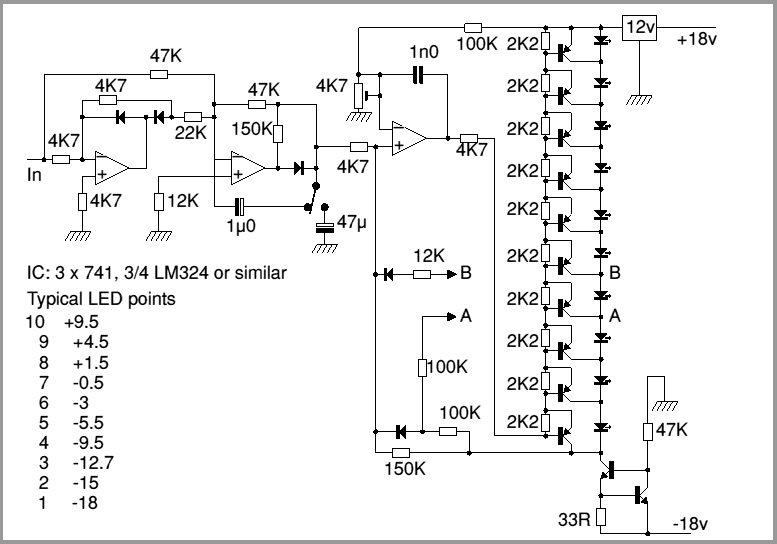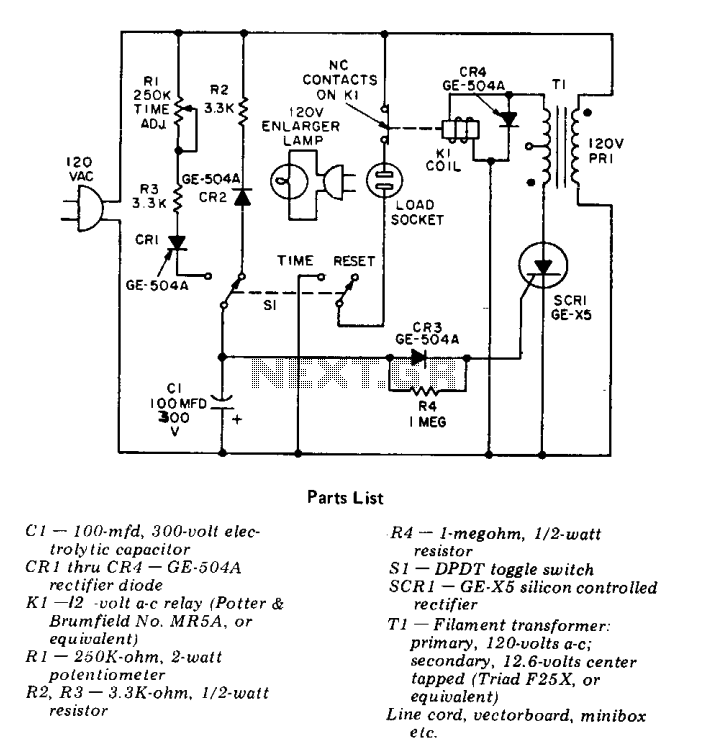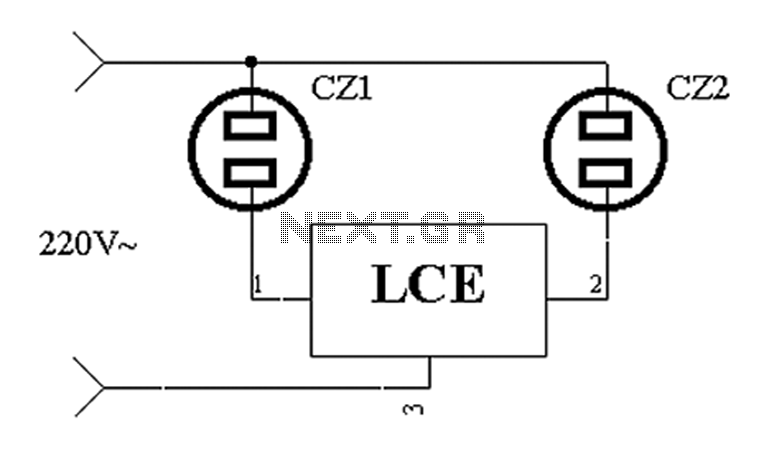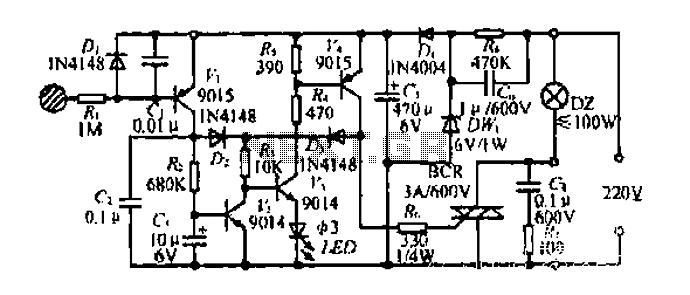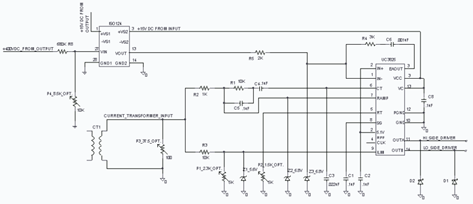
Four independent charging single battery automatic charger circuit
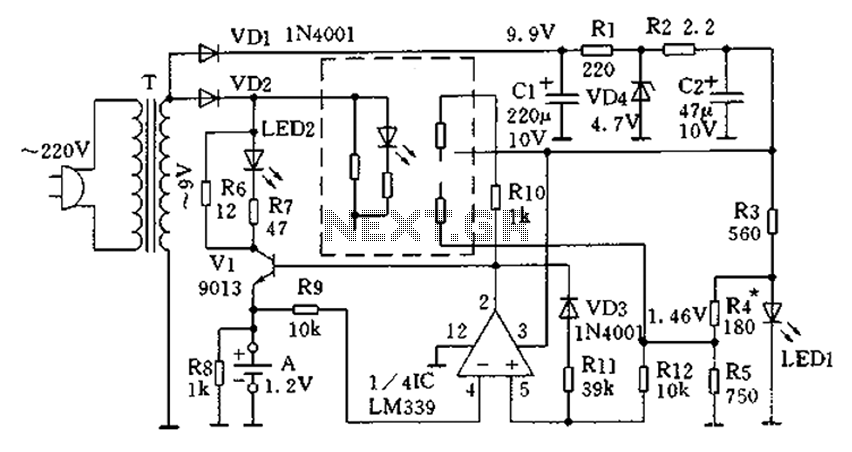
The circuit operates for 10 hours using constant current charging, providing convenience. The electricity from the secondary transformer T is stepped down, with the output directed through VD1 for rectification, followed by R1 and C1 for filtering. VD4 regulates the output voltage to 4.6V, while another path through VD2 delivers four half-wave rectified pulse currents for charging. Only one control circuit is illustrated, with the remaining three functioning similarly. The control manifold consists of four comparators LM339, where the non-inverting input is stabilized at 1.46V, established by R3. The power indicator LED1 receives a stabilized voltage of 1.9V through R4, with partial voltage provided by R5 and R12. The inverting input of the comparator reflects the voltage change of the rechargeable battery. Since the comparator input does not draw current, R9 ensures no voltage drop occurs across R12, allowing accurate voltage comparison. When the battery voltage is low, the high potential at the inverting input activates the control MOSFET V1, forming the charging circuit. Simultaneously, the charging indicator LED2 illuminates. When the battery voltage reaches 1.46V, the comparator output goes low, turning off V1 and halting the charging circuit, leading to a drop in battery voltage. Due to the influence of VD3 and R11, a certain hysteresis is introduced to prevent oscillation. Charging resumes only when the battery voltage drops significantly, causing the comparator output to become high, thus activating V1 again. This intermittent charging state is indicated by the blinking of LED2. As the battery charges, the intermittent time increases, and the frequency of LED2 blinking decreases until it remains off, indicating a fully charged battery. R10 serves as a load resistor for the comparator output, while R8 prevents control issues in case of a faulty battery. R4 allows for adjustable threshold settings of the quad voltage comparator, enabling fine-tuning based on the battery's age. The charging current varies with the charging voltage, reaching a maximum of 110mA, which can be fine-tuned by adjusting R6.
The circuit is designed to efficiently manage the charging of a rechargeable battery using a constant current approach. The primary components include a transformer, rectifiers, filters, comparators, and MOSFETs, which work in conjunction to maintain a stable charging voltage and current. The transformer steps down the AC voltage to a lower level suitable for the battery charging circuit. The rectification process converts the AC voltage to DC, which is then filtered to smooth out any ripples, providing a stable voltage output.
The use of LM339 comparators allows for precise monitoring of the battery voltage. The output of these comparators is critical for controlling the MOSFET, which acts as a switch in the charging circuit. The hysteresis introduced by VD3 and R11 is essential for preventing rapid on-off cycling of the charger, which could otherwise lead to inefficiencies and potential damage to the battery.
The charging indicators provide visual feedback regarding the charging status. LED1 indicates power to the circuit, while LED2 signals the charging process. The adjustable components, such as R4 and R6, allow for customization of the charging parameters, accommodating different battery types and conditions. This flexibility is particularly useful for applications where various battery chemistries may be used, ensuring optimal charging performance.
Overall, this circuit exemplifies a well-designed battery management system that incorporates essential features for safe and efficient charging, ensuring longevity and reliability of the rechargeable battery.10 hours using the constant current charging, use more convenient, the circuit shown in FIG. Electricity through the secondary transformer T stepped down, all the way from the rear VD1 rectifier, R1, C1 filtering, VD4 regulated by R2, C2 secondary filter output 4.6V regulated voltage control circuit for four; another route VD2 It provides four half-wave rectified pulse current for charging. Only one is shown the way in which the control circuit, the remaining three are the same way. Control manifold with four comparator LM339, its non-inverting input voltage 1.46V to stabilize, which is on the R3, the power indicator LED LED1 get 1.9V stabilized voltage by R4, R5 partial pressure provided by R12; and a comparator inverting input is reflected in the change in voltage of a rechargeable battery, since the input of the comparator does not consume current, R9, no voltage drop on R12, the comparator can truly reflect the comparison voltage size.
When charging the battery voltage is low, the potential of high-inverting input terminal, a control MOSFET V1, the charging circuit is formed. At the same time charging indicator light emitting diode LED2 lights; When the rechargeable battery voltage reaches 1.46V, the comparator output low potential, V1 off, cut off the charging circuit and the battery voltage begins to fall, due to VD3, R11 branch influence, more has a certain hysteresis, comparator avoid oscillation state.
Only the battery voltage drop is large, and the output of the comparator was a high potential so that V1 conduction, charging resumes. Such state of charge of the battery is intermittent, LED2 blinking, the battery is charged with the increase in intermittent time getting longer, LED2 blinking with increasing frequency is low, keeping the last in a long time off status indicates battery is fully charged.
R10 comparator output load resistance. Out of control when the battery is bad R8 prevented. R4 Adjustable Quad voltage comparator threshold comparator can also be fine-tuning their own based on the age of the battery being charged. Charge current with the charging voltage increases and decreases, the measured maximum of 110mA, the current size by changing R6 to fine-tune.
The circuit is designed to efficiently manage the charging of a rechargeable battery using a constant current approach. The primary components include a transformer, rectifiers, filters, comparators, and MOSFETs, which work in conjunction to maintain a stable charging voltage and current. The transformer steps down the AC voltage to a lower level suitable for the battery charging circuit. The rectification process converts the AC voltage to DC, which is then filtered to smooth out any ripples, providing a stable voltage output.
The use of LM339 comparators allows for precise monitoring of the battery voltage. The output of these comparators is critical for controlling the MOSFET, which acts as a switch in the charging circuit. The hysteresis introduced by VD3 and R11 is essential for preventing rapid on-off cycling of the charger, which could otherwise lead to inefficiencies and potential damage to the battery.
The charging indicators provide visual feedback regarding the charging status. LED1 indicates power to the circuit, while LED2 signals the charging process. The adjustable components, such as R4 and R6, allow for customization of the charging parameters, accommodating different battery types and conditions. This flexibility is particularly useful for applications where various battery chemistries may be used, ensuring optimal charging performance.
Overall, this circuit exemplifies a well-designed battery management system that incorporates essential features for safe and efficient charging, ensuring longevity and reliability of the rechargeable battery.10 hours using the constant current charging, use more convenient, the circuit shown in FIG. Electricity through the secondary transformer T stepped down, all the way from the rear VD1 rectifier, R1, C1 filtering, VD4 regulated by R2, C2 secondary filter output 4.6V regulated voltage control circuit for four; another route VD2 It provides four half-wave rectified pulse current for charging. Only one is shown the way in which the control circuit, the remaining three are the same way. Control manifold with four comparator LM339, its non-inverting input voltage 1.46V to stabilize, which is on the R3, the power indicator LED LED1 get 1.9V stabilized voltage by R4, R5 partial pressure provided by R12; and a comparator inverting input is reflected in the change in voltage of a rechargeable battery, since the input of the comparator does not consume current, R9, no voltage drop on R12, the comparator can truly reflect the comparison voltage size.
When charging the battery voltage is low, the potential of high-inverting input terminal, a control MOSFET V1, the charging circuit is formed. At the same time charging indicator light emitting diode LED2 lights; When the rechargeable battery voltage reaches 1.46V, the comparator output low potential, V1 off, cut off the charging circuit and the battery voltage begins to fall, due to VD3, R11 branch influence, more has a certain hysteresis, comparator avoid oscillation state.
Only the battery voltage drop is large, and the output of the comparator was a high potential so that V1 conduction, charging resumes. Such state of charge of the battery is intermittent, LED2 blinking, the battery is charged with the increase in intermittent time getting longer, LED2 blinking with increasing frequency is low, keeping the last in a long time off status indicates battery is fully charged.
R10 comparator output load resistance. Out of control when the battery is bad R8 prevented. R4 Adjustable Quad voltage comparator threshold comparator can also be fine-tuning their own based on the age of the battery being charged. Charge current with the charging voltage increases and decreases, the measured maximum of 110mA, the current size by changing R6 to fine-tune.
